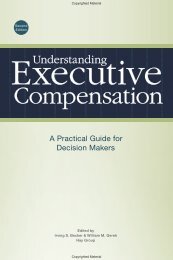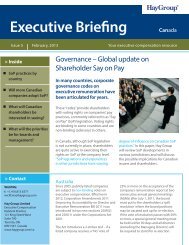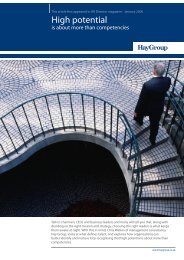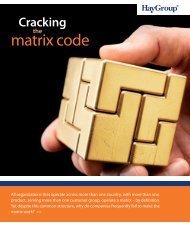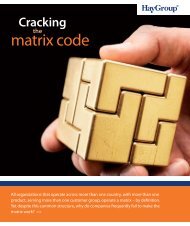Gettting things done: Improving decision-making - Hay Group
Gettting things done: Improving decision-making - Hay Group
Gettting things done: Improving decision-making - Hay Group
You also want an ePaper? Increase the reach of your titles
YUMPU automatically turns print PDFs into web optimized ePapers that Google loves.
Text box 1 – 200 words, use this style heading [HG Sub-head 1]<br />
Getting <strong>things</strong> <strong>done</strong>: <strong>Improving</strong> <strong>decision</strong>-<strong>making</strong><br />
Delivering strategy or the day-to-day<br />
business of an organisation, requires<br />
executives and managers to come<br />
together to make collective <strong>decision</strong>s.<br />
We are frequently told just how difficult it is to get <strong>decision</strong>s<br />
made at the right pace and to the right quality and that the<br />
organisation is ‘too slow’. Worse still, it’s getting the results of<br />
Next<br />
the <strong>decision</strong><br />
insert one<br />
executed<br />
sentence<br />
that<br />
for<br />
can<br />
use<br />
cause<br />
as the<br />
the<br />
sub-heading.<br />
biggest headache.<br />
Approx.<br />
In<br />
15-<br />
20<br />
effect,<br />
words<br />
strategy<br />
– it will<br />
gets<br />
use<br />
lost<br />
around<br />
in translation.<br />
about this much total space. [HG<br />
Sub-heading cover]<br />
This failure to get <strong>decision</strong>s made and enacted effectively is<br />
costly, market opportunities can be missed and the best<br />
employees become frustrated, unproductive or leave. We<br />
believe that the traditional approach to improving <strong>decision</strong><br />
<strong>making</strong> is flawed. It is based on ensuring accountability for<br />
<strong>decision</strong>s, <strong>making</strong> sure that everyone understands what <strong>decision</strong><br />
they’re Next insert being one asked sentence to make, for and use that as the <strong>decision</strong>-makers sub-heading. Approx. have the 15-<br />
‘right’ 20 words information – it will use on which around to about base a this <strong>decision</strong>. much total This is space. [HG<br />
inadequate Sub-heading as cover] it ignores too much of the real political and<br />
cultural backdrop against which <strong>decision</strong>s are made in<br />
companies. Properly tailored <strong>decision</strong>-<strong>making</strong> simulations which<br />
capture this information but include the wider political and<br />
cultural backdrop, have reduced unproductive management time<br />
for several of our FTSE 350 and Fortune 500 clients and improved<br />
their ability to react to events and make <strong>decision</strong>s accordingly.<br />
There is a huge opportunity for<br />
organisations that can address<br />
this issue to create a real<br />
advantage for themselves, and<br />
make significant strides in<br />
delivering their strategy.<br />
The <strong>decision</strong>-<strong>making</strong> problem<br />
<strong>Hay</strong> <strong>Group</strong> owns the largest database of management<br />
information in the world, and this gives us unique insights into<br />
how companies are structured, employees are managed and<br />
executives lead. While reducing headcount and removing<br />
management tiers has had a beneficial effect on the ability of<br />
companies to transmit information from one end of the<br />
company to the other, having fewer people, with broader roles<br />
has made <strong>decision</strong>-<strong>making</strong> more difficult. Companies have also<br />
responded to greater market complexity by introducing<br />
‘matrix’ 1 management structures and in global organisations<br />
where the responsibilities of local and head-offices are in flux,<br />
an organisation’s ability to make sound <strong>decision</strong>s has often<br />
deteriorated.
Getting <strong>things</strong> <strong>done</strong>: <strong>Improving</strong> <strong>decision</strong>-<strong>making</strong><br />
The employee perspective<br />
Our data shows that they too are frustrated by the way <strong>decision</strong>s<br />
are made. This data is taken from our global employee opinion<br />
database (5.5 million participants) and showed that in the UK:<br />
• 55 per cent report that their organisations are unable to<br />
make timely <strong>decision</strong>s<br />
• 41 per cent say that <strong>decision</strong>s are not made at the<br />
appropriate level<br />
• 37 per cent believe that their firms cannot respond flexibly<br />
to the changing business environment.<br />
A flawed approach to resolving the problem<br />
The most commonly advocated approach to improving the speed<br />
and quality of <strong>decision</strong>-<strong>making</strong> is to do three <strong>things</strong>:<br />
1. Be clear on who makes the <strong>decision</strong>, or at what level certain<br />
types of <strong>decision</strong>s get made (often determined using RACI or<br />
similar methodology).<br />
2. Base the <strong>decision</strong> on the right information by un-cluttering<br />
the data set.<br />
3. Encourage managers to be decisive and make <strong>decision</strong>s –<br />
often by providing ‘theory and discussion’ type training<br />
programmes.<br />
Leaving aside the questionable value of class-room based<br />
training it’s clear to anyone actually working in a business that<br />
the traditional approach is flawed because it ignores too much<br />
about what a company is like and how people actually behave.<br />
While the first point is broadly sound: many organisations do<br />
have managers who are too far into the weeds and doing the<br />
jobs of the people reporting into them, or busy strategising when<br />
they ought to be implementing- the other points are less helpful.<br />
Take the second for instance. At first glance, it appears<br />
uncontroversial: a characteristic of a good <strong>decision</strong> is that it is<br />
based on the right information. But what is right? Our<br />
experience is that organisations and systems are rarely lacking in<br />
data: the issue is whether the data set has been established as fit<br />
for the task, its limitations and assumptions are understood, and<br />
that there is an answer to the question of ‘what is enough?’<br />
Without a shared understanding, people question whether the<br />
information is complete, should be interpreted in another way,<br />
or has been manipulated to suit someone else’s agenda. If any of<br />
these worries are prevalent, <strong>decision</strong>s are not trusted and are<br />
then often blocked higher or lower down in the organisation. At<br />
the very least, the <strong>decision</strong> process slows down because<br />
everyone has to have their ‘say’.<br />
Common approaches fail<br />
to address how <strong>decision</strong>s<br />
really get made in the real world;<br />
against a political and cultural<br />
back-drop which <strong>decision</strong>makers<br />
cannot ignore<br />
The real political and cultural back-drop<br />
Establishing the accountabilities for who makes the <strong>decision</strong>,<br />
and developing their <strong>decision</strong> <strong>making</strong> capability is important,<br />
as is having the right information. But on their own they fail<br />
to tackle the wider issue of why <strong>decision</strong>s are not made well,<br />
trusted and then executed. In the real world, <strong>decision</strong><strong>making</strong><br />
does not happen according to a process but takes<br />
place in a political and cultural setting. Examples of <strong>things</strong><br />
that de-rail <strong>decision</strong>-<strong>making</strong> are:<br />
• Decision-makers come together from different parts of<br />
the company and have different, often competing<br />
agendas. The <strong>decision</strong> people are being asked to<br />
participate in is not necessarily top of everyone’s<br />
agenda and the differing implications for individuals has<br />
not been discussed or dealt with. The result is that the<br />
<strong>decision</strong> does not get carried through.<br />
• Many ‘rooms’ make <strong>decision</strong>s, which are then<br />
sabotaged, slowed down or briefed against by the very<br />
same people who were in the room.<br />
• The culture of the company does not encourage anyone<br />
to take a risk. The apparatus of performance<br />
management, bonus systems and ‘the way <strong>things</strong> get<br />
<strong>done</strong> round here’ reinforce a message to ‘carry on as<br />
usual’ much to the frustration of executives who want<br />
to cut through all this organisational clutter to actually<br />
get <strong>things</strong> <strong>done</strong>. The executives themselves may be<br />
guilty of reinforcing the risk adverse way of doing<br />
<strong>things</strong>.<br />
• Decisions requiring cross-party agreement rarely need<br />
to be taken at a time or pace that suits all parties. Being<br />
clear about which types of <strong>decision</strong>s need to be made<br />
quickly, which need to be socialised and which need to<br />
be ‘brokered’ needs to be bespoke to both the <strong>decision</strong><br />
required and the company itself.<br />
• Different parties to the <strong>decision</strong> don’t really agree what<br />
the <strong>decision</strong> actually was and why it was made.<br />
Needless to say, a good <strong>decision</strong> arrived at in this way<br />
will still get mired in the organisation.<br />
Many ‘rooms’ make <strong>decision</strong>s, which are then sabotaged, slowed down<br />
or briefed against by the very same people who were in the room<br />
2
Getting <strong>things</strong> <strong>done</strong>: <strong>Improving</strong> <strong>decision</strong>-<strong>making</strong><br />
The solution: tailored simulation<br />
The problem with traditional process and training type<br />
approaches is that they fail to reflect the unique situation of<br />
individual companies and therefore fail to tackle the problems<br />
outlined in the previous section. We have found that the best way<br />
of tackling this issue is through expert-facilitated simulations:<br />
modelling the real life <strong>decision</strong>s that need to be improved and<br />
allowing leaders to go through the cycle of events, data and<br />
forums that are typically involved. Only then do they begin to<br />
notice and agree the right conditions for improving the <strong>decision</strong><strong>making</strong><br />
process and outcomes.<br />
What does this involve?<br />
Understanding the organisational context. The facilitator will<br />
require an overview of the organisation so as to be able to frame<br />
the scenario in the context of the broader business and the<br />
stakeholders to whom the <strong>decision</strong>-makers are answerable. It is<br />
important that the simulation is run by someone with a good grip<br />
on the company’s overarching strategy and how different parts of<br />
the organisation are tasked to deliver on that strategy.<br />
Select the scenarios. Careful consideration needs to be given to<br />
what real life scenarios are simulated. It is important to model<br />
scenarios on instances that are proving difficult (recognising that<br />
most organisations and systems are good at some <strong>decision</strong>s) and<br />
that are consequential to the organisation’s purpose, and to<br />
stakeholders requirements. It is helpful if the scenarios selected<br />
can highlight tensions in the organisation’s operating model.<br />
Meet the <strong>decision</strong>-makers. Real life <strong>decision</strong>-makers need to be<br />
brought together. The facilitator will need to meet with each<br />
individual beforehand to understand two <strong>things</strong>: the business<br />
context for their participation in the meeting and the way that<br />
they as an individual think, operate and express themselves.<br />
Run the scenarios. The meeting is run as if it were for real but<br />
with an expert facilitator there ‘pressing the pause button’ to<br />
unpack issues the group have skirted over and ‘pressing the<br />
rewind button’ either to reset the conversation in the context of<br />
post-<strong>decision</strong> implementation or to ensure that each person in<br />
the room has the same understanding of what another person<br />
has said or recommended. Experience with senior teams here is<br />
vital, as is the ability to rapidly understand how sub-teams get<br />
formed.<br />
The outcome is not simply a RACI style ‘implementation<br />
guide’ determining how to assign responsibilities and<br />
actions to individuals. As we said earlier this process-driven<br />
approach does not work, instead it will:<br />
• describe how the <strong>decision</strong>-<strong>making</strong> group or team<br />
behaves, how that compares to more effective<br />
<strong>decision</strong>-<strong>making</strong> teams and what to do to improve.<br />
• describe how the group processed the <strong>decision</strong> and<br />
how that processing can be improved, given your<br />
unique environment and indeed the unique people in<br />
the room. At this stage the issue of ‘sub-teams’ is<br />
often addressed.<br />
• describe the role of individuals in the meeting,<br />
articulating how they best impact on the <strong>decision</strong> in<br />
the room and therefore can best be ‘used’ when<br />
<strong>decision</strong>s need to be made in the future. This can<br />
involve developing a common understanding of<br />
which roles are best for people to play given their<br />
unique responsibilities, style and role in the<br />
implementation of the <strong>decision</strong>.<br />
Export back into the business. The learning from this realtime<br />
simulation, expertly facilitated with an eye to the<br />
dynamics of the <strong>decision</strong>-<strong>making</strong> group, can then be<br />
exported into the real environment. From our experience<br />
client’s have seen rapid and dramatic improvements in<br />
their <strong>decision</strong>-<strong>making</strong> process with benefits including:<br />
• unproductive management time is often markedly<br />
reduced, with leaders reporting that they now only<br />
go along to meetings “when I’m needed and it<br />
matters”. The number of people involved in a<br />
<strong>decision</strong> is often fewer than originally thought, and<br />
there’s greater trust and confidence that those<br />
involved will make the right <strong>decision</strong>.<br />
• key <strong>decision</strong> processes have been modelled ahead of<br />
time and made better, avoiding some of the fallout<br />
that typically occurs when the existing process goes<br />
awry in real time.<br />
• creation of a ‘fact bible’ – for example, streamlining<br />
of management information and its interpretation.<br />
Provide feedback. The learning from this real-time simulation<br />
needs to be exported into the real environment.<br />
“Our clients have told us that execution improves more<br />
broadly as executives lead their areas with a sharper sense<br />
of how the whole comes together, and that change<br />
programmes are more targeted than they were in the past.”<br />
3
Summary<br />
Executives and managers are spending more and more time coming together to make <strong>decision</strong>s.<br />
Yet this time is often unproductively used and <strong>decision</strong>s made fail to get acted on or properly<br />
followed through. Resolving this can produce a real advantage. Common approaches to doing so<br />
are flawed, however, as they ignore the real cultural and political backdrop against which<br />
<strong>decision</strong>s are made.<br />
Our approach – tailored simulation. It reduces unproductive time, ensures the right number of<br />
people are in the room and increases trust and confidence amongst <strong>decision</strong>-makers that the<br />
<strong>decision</strong> will get made and followed through.<br />
End notes<br />
1. <strong>Hay</strong> <strong>Group</strong> ‘Managing in the matrix’ and ‘Cracking the matrix code’<br />
Contact your <strong>Hay</strong> <strong>Group</strong> team<br />
Matt Crosby<br />
matt.crosby@haygroup.com<br />
+44 (0) 20 7856 7313<br />
Jon Dymond<br />
jon.dymond@haygroup.com<br />
+44 (0) 20 7856 7249<br />
<strong>Hay</strong> <strong>Group</strong> is the leading global provider of consulting on organisation, people and change.<br />
We help business leaders connect the organisational, people and cultural assets that underpin business<br />
performance and by linking these to hard financial outcomes help organisations reduce costs and improve<br />
performance.<br />
Our expertise has been developed through 70 years of experience working with over 8000 clients<br />
worldwide. Our work is evidence based and is backed by the world’s most comprehensive databases of<br />
organisational management information.<br />
Our 2,600 employees working in 85 countries in 48 countries are chosen for their ability to work with you to<br />
connect business and people issues, and deliver workable solutions as well as original insights.<br />
© <strong>Hay</strong> <strong>Group</strong>. All rights reserved



